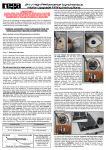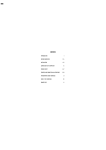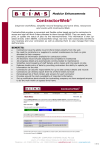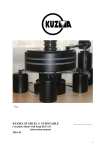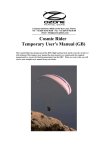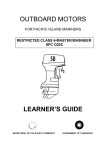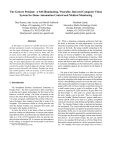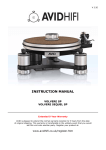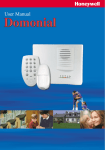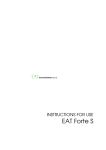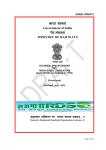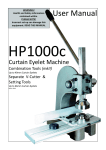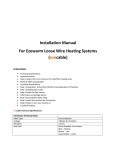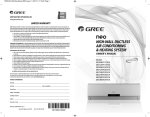Download RP8 English manual:Apollo English manual.qxd.qxd
Transcript
- CONTENTS INTRODUCTION / EVOLUTION OF REVOLUTION 1 TURNTABLE DESIGN & MYTHOLOGY 2 DESIGN AND INNOVATION 3-7 SETTING UP YOUR RB808 7 SETTING UP YOUR TURNTABLE 8 TTPSU / CONNECTION TO THE AMPLIFIER 9 TTPSU CONTROL AND CONNECTION CARE OF THE TURNTABLE 10 11-12 TRANSPORTING YOUR TURNTABLE 12 OWNERS LOG 13 INTRODUCTION The RP8 has been designed and engineered to achieve outstanding performance way beyond the expectations of a product at this price point. Excellent build quality, reliability and ease of use combine to make a product which, if used correctly, will offer you a lifetime of musical enjoyment. The RP8 takes Rega’s design philosophy further than ever before. A radical new plinth using custom designed materials, a new tonearm bearing assembly, a 24V low voltage motor controlled by a hand tuned electronic power supply and a custom version of our Planar 9 engineered hub bearing assembly. These are just some of the features of this amazing new turntable designed to extract more music from your vinyl than ever before. THE EVOLUTION OF REVOLUTION Evolution is a well proven and documented process in many areas of our lives. This applies in particular to design engineers and machines. Over the past forty years our cars have become more reliable and economical whilst we take for granted the safety and speed of modern aircraft. Rega is no exception to evolution. Rega’s experience and previous achievements allow us to continually develop and produce better products. The RP8 represents probably the biggest step forward in the evolution of Roy Gandy’s turntable design philosophies. Low mass, high rigidity plinths combined with electronically controlled low vibration motors, high flywheel effect platters and lower mass, higher stability tonearms. The RP8 is the first of our new “skeletal” design turntables offering groundbreaking levels of performance and amazing value for money. 1 TURNTABLE DESIGN & MYTHOLOGY Today there are many approaches to Hi-Fi design which follow established and informed engineering or electronic principles. Amplifier and loudspeaker design has been well documented over the years with excellent technical publications. These subjects have been based on tried and tested acoustic criteria and many computer software programs now exist that enable a near amateur to design a passable working loudspeaker based on known acoustic and mathematical parameters. Enter turntable design: When it comes to turntable design we are limited to a few poorly informed articles describing only very limited aspects of design. This is a subject full of mythology. Designers propose theories that counter the basic laws of physics, use terminology that doesn’t actually exist in the engineering world, build products that are more like beautiful sculptures than acoustic reproduction machines and sell items costing tens of thousands of pounds that hardly function as intended and often fail to work at all. For instance a very common myth is “the heavier the better”. Turntable bases weighing tens of kilograms are not uncommon. The reality is that the base actually needs to be as light as possible to prevent unwanted bearing and motor noise being transferred to the turntable or record. Platters also fall under a similar myth with many platter designs becoming so heavy that it is impossible to design a correctly functioning bearing (and some so light that anyone can hear the speed inconsistency). The turntable platter itself needs to be of enough weight to spin at a constant speed within the confines of the chosen bearing and motor drive system. Many amateur designers in any field choose one component in a design and try to achieve an extreme in size, weight and quality. They believe that by taking one theory to its extreme the design will become “perfect”. The reality of all engineering, design (and life) is that perfection is not possible. Based on this reality, Rega’s goal has always to optimise a mixture of numerous “correct compromises” thus bringing the designer nearer to the unachievable goal of perfection. 2 DESIGN AND INNOVATION SKELETAL PLINTH DESIGN WITH POLYOLEFIN FOAM CORE Controversially Rega has always researched methods of producing light but stiff and rigid plinths. The technology is simple: unwanted noise at microscopic levels is developed by the turntable motor and main bearing. The plinth can also pick up airborne vibration from the music. From the beginning in the 1970’s Rega pioneered the use of a stressed skin structure for the plinth. This uses two layers of phenolic resin with a lightweight particle or fibre board sandwiched between the skins. This technique has been used in many applications where stiff, light structures are needed such as an aircraft wing or a Formula 1 chassis. The current revival in turntables has allowed Rega to research and develop higher technology structures for the customer who is happy to pay a little more for higher sound quality. The RP8 turntable utilises a unique new stressed skin structure produced from thin phenolic skins sandwiching a featherweight nitrogen expanded, closed cell, polyolefin foam core. This material has been developed exclusively for Rega over a three year period. The RP8 plinth is 7 times lighter than the weight of the original Planar 3 plinth. In addition Rega has added even more stiffness in the crucial area between the arm and the main bearing. SUPER FLYWHEEL EFFECT TRIPLE LAYER GLASS PLATTER The new RP8 three piece laminated glass platter is the result of a collaboration with a small, emerging, young British glass engineering company. As a general rule the only part of a turntable that requires extra mass is the turntable platter in order to achieve constant rotational speed. However a heavier platter creates more problems for the main bearing design so again an ideal compromise creates the best solution. 3 Practically this means keeping as much of the mass to the outside rim of the glass platter to create more flywheel effect while keeping the inside of the platter as light as possible without sacrificing stiffness. The RP6 was the first Rega turntable to use a precision engineered glass ring laminated to the outside using modern CNC techniques to ensure concentricity. The RP8 takes it one step further by laminating three rings together to produce the RP8 super flywheel effect glass platter which we consider an engineering triumph ! MAGNESIUM AND PHENOLIC - DUAL BRACING A super lightweight plinth combined with a double brace mounted specifically where the increased rigidity is required (between the tonearm mounting and the main hub bearing) forms a structurally sound “stressed beam” assembly. This design prevents energy absorption and unwanted resonances which will add unnatural distortions to the music. The RP8 takes our double brace technology to the next level. Not content with an unprecedented stiffness to mass ratio, Rega has obsessively reduced any resonant properties by using two different materials for the new stressed beam. The top layer is magnesium and the bottom layer is phenolic (two of the lightest and stiffest materials available). Incorporating two different materials into the brace structure lowers their ability to pick up unwanted airborne vibrations. Simply put, different materials have different natural resonances. By using two different materials together they decrease the natural frequency of each other by self damping. 4 MOTOR The motor is a high specification, 24V twin phase synchronous unit which has a board mounted anti vibration circuit hand tuned to each motor. It is controlled by Rega's unique and innovative TTPSU power supply. The motor drives the CNC machined pulley, sub platter and hub-bearing assembly via the twin belt drive. TTPSU - POWER SUPPLY Your RP8 turntable motor is hand tuned and matched to the supplied TTPSU, this ensures the maximum reduction of motor noise and vibration is achieved. The compact TTPSU itself uses a high stability crystal locked low distortion sine wave generator. This, along with an efficient drive amplifier fed from a stabilised DC power supply, generates a 24V AC balanced signal of less than 0.1% distortion, which is completely un-affected by any changes in the mains/line voltage and conditions. This then drives the improved Rega anti-vibration circuit, which is situated beneath the turntable. The speed change is achieved by changing the frequency of the drive voltage; this is because the speed of the platter and motor is directly proportional to the motor drive frequency. A relay changes the required phase compensation & the anti vibration circuit which eradicates motor vibration to a minimum at both speeds. 5 TONEARM The RB808 tonearm is packed with new features pushing the boundaries of tonearm design. As with all Rega tonearms each one is meticulously hand built by a team of highly skilled technicians. The RB808 has improved bearings and a tightened spindle fit tolerance over previous models (each bearing is individually selected to find the perfect match for the chosen spindle). This is a Rega developed method of increasing the amount of detail retrieved from the record surface. A brand new low mass precision engineered vertical bearing assembly has been manufactured to further compliment the inherent design philosophy of the RP8 turntable. The RB808 uses the latest Rega arm tube. Completely redesigned to redistribute mass, further reduce stresses and resonances. This advanced design tube increases the stiffness and rigidity of the overall assembly using CAD design to blend the multiple varying tapers. NTERCONNECTS I Externally we have fitted a bespoke Rega designed low capacitance phono cable which uses an advanced phono plug assembly. This has only two parts to minimise joints and incorporates a twist and clamp design locking the plug to the terminal. The design increases connectivity and ensures the signal path is kept as clean as possible. 6 DE-COUPLED OUTER FRAME AND DUST COVER A common problem for many skeletal design turntables is the inability to incorporate an effective dust cover into the design. We have constructed an outer frame that minimises contact between the inner and outer plinth. The only points of contact are three location devices on the feet which centralises the inner and outer plinths perfectly. This makes set-up extremely easy and allows the use of a dust cover. The RP8 can be used without the outer frame if so desired. PLEASE NOTE: ALWAYS REMOVE THE GLASS PLATTER BEFORE LIFTING OR RELOCATING THE RP8 Always remove the glass platter before locating the RP8 central plinth into the outer frame or when lifting the whole turntable to relocate it. The ‘o’ rings will not centralise the plinth within the frame if the weight of the platter is present. SETTING UP YOUR RB808 With the cartridge mounted correctly and set up using the alignment protractor supplied, ensure that the tracking force control and bias adjustment slider are set to zero. (Pull the bias adjustment fully out to set zero). Slide the balance weight along its shaft until the stylus is “floating” just 1mm clear of the record. The recommended tracking force can now be applied via the tracking force control shown on page 8. Always use a force which corresponds to the upper limit of the cartridge makers recommended range. Push the bias adjustment slider to the same number as the tracking force control. ie a recommended 2.0g tracking force = 2.0 on the bias slider. Note: It is not necessary to use the alignment protractor if the turntable has a factory fitted Rega cartridge. 7 SETTING UP AND POSITIONING YOUR RP8 TURNTABLE. Always take great care when unpacking the turntable. Extra care must be taken if your RP8 is supplied with a cartridge factory fitted so as not to damage the stylus. Place the turntable on a sound and level surface. The RP8 inner plinth sits within the outer frame, locates and self centralises via three rubber triangulated ‘o’ rings. Ensure correct alignment and check that the tonearm phono lead assembly and motor lead are clear of the feet and are not contacting the plinth. Drive Belts Drive Pulley Top Brace Balance Weight Tracking Force Control Bias Adjustment Glass Platter Alignment Protractor 2g 1g 8 TTPSU Connect the turntable power interconnect between the TTPSU and the turntable. Make sure the PS1 mains transformer is plugged in and connected to the 24V AC input terminal in the back of the TTPSU. Switch the mains power on. To minimise the risk of hum pick up by the cartridge, the power supply should be situated as far from the turntable as the interconnect cable will allow. Push the power button on the front panel to turn the TTPSU on - When the power supply is switched on, the Rega logo will illuminate RED, This indicates that 33 rpm is selected. To activate 45 rpm, press the button again and the Rega logo will illuminate GREEN, indicating 45 rpm has been selected. CONNECTION TO THE AMPLIFIER The tonearm external phono leads must be connected to your amplifier’s phono stage. Connect as follows : Red right channel / Black left channel. If your amplifier does not have an integrated phono stage you will require an external stage (sold separately). 9 FRONT PANEL CONTROLS Rega logo ‘speed indicator’ Power switch 331/3 / 45RPM Speed change REAR PANEL CONNECTIONS Connect to Rega PS1 24V transformer Turntable power connection . 10 CARE OF YOUR TURNTABLE Mount the turntable on a rigid, level surface. Avoid mounting on hollow or heavy cabinets or anything mounted on a flexible wooden floor. The Rega turntable support is the ideal solution. Keeping the lid closed while playing records will prevent dust falling on to the record surface and should make cleaning unnecessary. Depending on the room environment and ambient temperature, playing with the lid open may offer sonic improvements. You can experiment to optimise the performance best suited to your room. Do not use any record cleaner that works while the record is playing or any cleaners that use water or solvents. If you keep your records stored in their sleeves, avoid touching the playing surfaces and keep all water and fluids away, cleaning should not be necessary. Do not worry about visible dust on the record surface as this is brushed aside by the stylus during play. Dust collected on the stylus can be easily blown away. In general, record cleaning is overdone and one should not believe all the claims made by record cleaner manufacturers. It is recommended to leave the turntable running during a record playing session. Switch on before the session and only switch off after you have finished. Do not lift the centre hub out from the main bearing. The bearing is factory assembled with a film of special thick lubricant. If the centre hub is removed this film may be disturbed and the accuracy of the turntable could be affected. The arm earth (or ground) is automatically connected through the arm cable screening. No other earth method should be necessary. 11 Do not use any polish on the turntable or lid. To clean, wipe gently with a soft cotton duster (slightly damp only if required). Rega turntables are designed to optimise performance for music reproduction and therefore no compromises have been made to give quick start times. The normal time taken for full speed to be reached is between 2 and 5 seconds. Warning: Any attempt to repair or modify the turntable or tonearm by persons other than Rega approved personnel may invalidate the guarantee. Should you experience any problem with your turntable please contact your Rega dealer. TRANSPORTING YOUR RP8 Should you need to transport your RP8, to avoid any possible transit damage, the following recommendations must be followed. Remove tonearm balance weight and secure the arm in its rest with tape or covered wire. This will ensure no sudden or violent movement is transmitted to the delicate bearings. To remove platter , hold down the hub centre at the same time as lifting the platter on each side. NEVER place your RP8 upside-down or on its side. This would allow oil in the hub/bearing assembly to leak and cause speed and/or wear problems. If you have to ship your turntable or use a carrier, save and use ALL of the original packaging. 12 OWNERS LOG (1) Owner....................................................................................................................................................... Date........................................................................................................................................................... Where Purchased................................................................................................................................. (2) Owner....................................................................................................................................................... Date........................................................................................................................................................... Where Purchased................................................................................................................................ (3) Owner....................................................................................................................................................... Date........................................................................................................................................................... Where Purchased................................................................................................................................ (4) Owner....................................................................................................................................................... Date........................................................................................................................................................... Where Purchased................................................................................................................................ (5) Owner....................................................................................................................................................... Date........................................................................................................................................................... Where Purchased................................................................................................................................ 13














